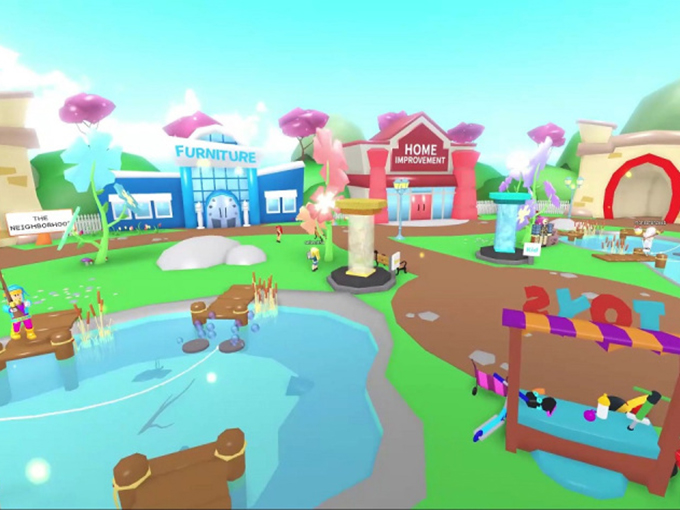The term “metaverse” has been floating around a lot lately. You might have heard it in the recent Spider-Man movie trailer, or when Mark Zuckerberg told employees it was the future. You might have even heard Spin Master talk about entering the Roblox (pictured) metaverse. But what exactly is the metaverse?
“Metaverse” refers to global, always-on spaces—primarily online—that are “omni-experiential.” In a true metaverse, users will consume and create across gaming, entertainment, learning, work, play and social engagement, all in a single connected immersive environment. In short, it’s a place made up of shared 3D virtual spaces that link together into a perceived virtual universe.
It’s not the metaverse with multiple timelines of reality, like you might see in Disney+’s Loki. If you want to equate it to pop culture, then its closer to Ready Player One.
Young people are primed for the metaverse—they’re already doing everything online, jumping seamlessly from one platform to another. Dubit’s global trends survey shows that on phones, tablets and PCs, they split their time almost evenly among video watching, game play, social media and learning activities. Looking at games specifically, more than 50% of nine- to 12-year-olds in the US play on Roblox at least weekly, while 10 of the top 14 game platforms used by American kids have a social play element.
Dubit is focusing on the metaverse right now—building an internal consultancy involving its research, strategy and digital development practices—because that’s where the kids are. And you should be, too,
Roblox is the “proto-metaverse”
A true metaverse doesn’t exist yet, but Roblox is the best approximation. Its CEO, David Baszucki, cites eight characteristics of a metaverse that are the foundation of the platform, but they also parallel the social and gaming preferences and desires of Generations Z and Alpha. Those characteristics are as follows: users having a persistent identity; a place where real-world and in-game friends can socialize; a feeling of immersion in the alternative world; geographic ubiquity; accommodation of a deep and wide variety of interests; easy onboarding; an internal economy; and an inherent sense of trust and civility.
Roblox isn’t alone in foreshadowing the social, multi-purpose metaverse. Minecraft has always been a place for collaboration among friends, and has evolved modes of engagement for formal and informal learning. In 2018, Fortnite added a “creative mode” to its Battle Royale, letting users customize an island and invite friends to hang out and play.
How to prepare for the metaverse
It remains to be seen if there will be one metaverse or several. We don’t even know if any one company has the resources to build a full-fledged connected experience.
We won’t wake up one morning to discover a full-blown metaverse; it will evolve gradually as technologies improve, companies merge or collaborate, users hack new ways of using media, and creators envision new ways to tell stories, play and learn.
In the meantime, what should companies do to be “metaverse-ready?” Here are four recommendations for ensuring that you’re prepared to plug into future opportunities.
1) Build your experience in the best primary medium for your target audience, focusing on how your fans engage. Forge an expansion strategy that includes both new ways to interact with your content, and strategic connections to your fans’ other virtual “hang out” spots. The metaverse will be built like a community—piece by piece as users express their needs and wants.
2) Test how your brand translates into a wider experience on a relatively inexpensive platform like Roblox. Envisioning (if not actually launching) an immersive and interactive extension is a valuable exercise for learning where your brand needs further development to click into an inter-connected, multi-dimensional universe. Then you can continually iterate and adapt the experience based on audience feedback.
3) Understand that the metaverse isn’t only about gaming. The top digital destinations for tweens and teens—Minecraft, Fortnite (Creative), Roblox, Animal Crossing—are less focused on competition, and more on social connection, discovery, collaboration and mastery. Instead of games, many brands are creating experiences that embody their values: beautiful environments for hanging out, art or music exhibitions, and even ASMR immersions.
4) Develop a policy on how tightly to protect your IP when it comes to user-generated content. Gen Z and Gen Alpha were born into the expectation that they’ll find their favorite content wherever and whenever they want, no matter who created it. They also want to create something themselves as another way to experience their favorite stories. To the extent that you can loosen your grip a bit and permit (or even encourage) fan art, stories and games, you can learn a lot about how your best ambassadors view your brand, and gain discoverability you can’t buy.
I was concerned at first that “metaverse” was another buzzword like “transmedia” and “360 commissioning,” but there’s a key difference. These previous concepts were top down—from IP owner to audience. This often resulted in adults’ concepts of connected experiences that didn’t align with what kids wanted.
The metaverse will be different: Its creative evolution will be a collaborative give-and-take between brands and fans. An increasing number of kids’ favorite brands are digital-first, and Dubit Trends data indicates that young people spend almost as much time playing games as watching videos, and that they increasingly discover new brands and content through these games. They expect the digital world to be seamless and to evolve in response to how they use it. If you want to connect with young people in the metaverse, you need to learn to co-create.
David Kleeman is SVP of global trends for Dubit, a research and strategy agency and digital studio with an internal metaverse consultancy, Bloxstars. Dubit has created free reports providing insight into metaverse strategy, potential ROI and the presence of brands on Roblox (even those brands that don’t believe they have one!).






















